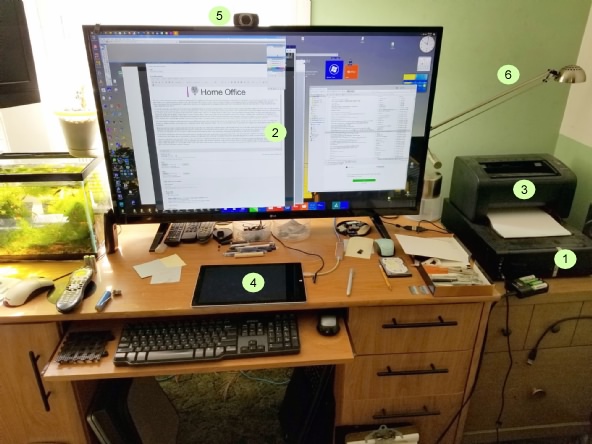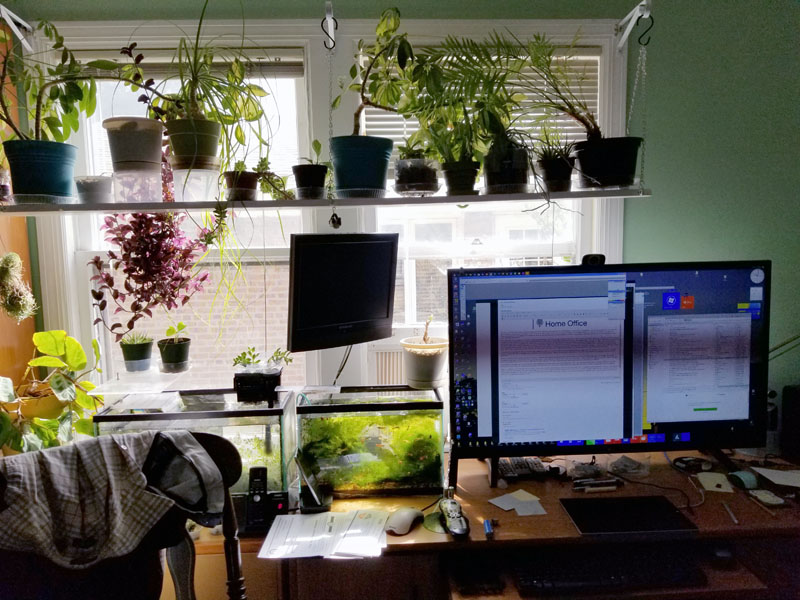HOME OFFICE SETUP

No, this is not a discussion of the ministerial department of Her Majesty's Government of the United Kingdom, responsible for immigration, security and law and order, but rather the place where you conduct work from home. Looks like the home office is here to stay. Once the realm of people lucky enough to work for a company that allowed some degree of telecommuting (or the self-employed) it's now almost universal and not projected to go away any time soon due to the pandemic. What do you really need to have an optimum and super-workable home office?
 First of all, much like real estate, the three most important things are location location location. You'll need to choose a space somewhere within your home that you can designate as your home office. Obviously there's a lot of considerations here. If you share your home with a partner and children, then options will be more limited. While many places that people live do not have spare rooms just waiting to be turned into a home office, some do. Or maybe there are some spaces that you wouldn't normally think of as office space but that can be converted. People can be wildly creative when it comes to home offices. Some spaces that have been converted to a home office include a laundry room, a workshop, an enclosed porch, guest room and even (strangely!) a spare bathroom, though that seems a bit less-than ideal (you could have really long video-conferences though...). I know someone who has a garden shed...almost like a small garage actually, that even has a gas heater. This would make a fantastic home office - your commute would be a walk through your backyard!.
First of all, much like real estate, the three most important things are location location location. You'll need to choose a space somewhere within your home that you can designate as your home office. Obviously there's a lot of considerations here. If you share your home with a partner and children, then options will be more limited. While many places that people live do not have spare rooms just waiting to be turned into a home office, some do. Or maybe there are some spaces that you wouldn't normally think of as office space but that can be converted. People can be wildly creative when it comes to home offices. Some spaces that have been converted to a home office include a laundry room, a workshop, an enclosed porch, guest room and even (strangely!) a spare bathroom, though that seems a bit less-than ideal (you could have really long video-conferences though...). I know someone who has a garden shed...almost like a small garage actually, that even has a gas heater. This would make a fantastic home office - your commute would be a walk through your backyard!.
Your office space will also depend on what you need job-wise. Maybe you need a fair amount of space to lay our drawings and plans. Maybe your job involves music or voice-over work and requires a studio-like office. In my own case, I sometimes repair client computers. I can do so in my home office. For larger jobs I use a basement dspace.
Wherever you find a space, I would urge you to set up in a spot that can remain your dedicated space and doesn't need to be taken down/put up as needed. This clearly depends on your space considerations and may not be practical, so if it needs to be dual use then so be it. For instance, my home office is also my bedroom. However, my bed is a futon that folds up during the day giving me a lot of space. I don't have to break-down the office space (which is primarily a desk and a small table) to use the space as a bedroom.
If you choose a dedicated space then your dedicated space should be made private with a door. This is not only important for phone and video conferences, but the seclusion of a door allows you to concentrate on business at hand and sends a message to everyone you're living with that you are "at work" and generally not to be disturbed.
Lighting is important, especially with regard to video conferencing. A window would be great if you can find a space with one. Facing the window will allow your own face to be well-lit for video connections. In my home office I face two windows, but a big chunk of them is blocked out by my 40" monitor (actually a 4k tv). Still there's plenty of light for video; sometimes too much as I have to lower the blinds so I can actually see the screen (this differs with the time of the year). A lamp is necessary for dreary days or nighttime work. I use an adjustable halogen lamp that I can move and swivel around as needed.
 Of course you'll need a chair; you can run the gamut from paying a lot for a high-end one or using whatever you have around the house to economize. Your chair will be better if it can roll, has lumbar support and is height-adjustable. More adjustments (seat pan tilt, arm height and lateral arm position) can really add to comfort when sitting for long periods of time. FYI arm rests are preferable (at least for me!).
Of course you'll need a chair; you can run the gamut from paying a lot for a high-end one or using whatever you have around the house to economize. Your chair will be better if it can roll, has lumbar support and is height-adjustable. More adjustments (seat pan tilt, arm height and lateral arm position) can really add to comfort when sitting for long periods of time. FYI arm rests are preferable (at least for me!).
The desk should be standard height for a desk - 29 inches from the floor to the top of the work surface. That's a bit too high for comfort in terms of keyboard height so if you can get a keyboard and mouse tray that pulls out from below the desk surface do so, your arms and hands will thank you. Supposedly everything is correct when you are sitting up straight and when typing your forearms are parallel to the floor and your wrists are not bent up or down. My forearms are parallel to the floor but my wrists are slightly bent down, so maybe I should l should lower my chair a bit.
You should be looking straight ahead at your monitor with your eyes 25 to 30% below the top of the screen, and that's right where mine is. If you don't have a big monitor you may need a monitor riser to sit it on. For multiple monitors you might consider one of those adjustable arms that clamp onto your desk to hold it. You could then stack one on top of the other or place them side-by-side.
A TOUR OF MY HOME OFFICE
Let's take a tour of my office space, by no means a shining example of home offices but something very workable for me.
 By the numbers we have:
By the numbers we have:
- My computer; easily reachable so I can plug USB peripherals like thumb drives in.
- My screen, an LG 40" HD TV screen.
- My printer, an inexpensive Dell monochrome laser printer, great for quick prints of a small amount of pages. Since it's right above my computer it's connected via a USB cable. I have a larger volume laser printer in the basement and behind me across the room a color printer/scanner.
- A Microsoft Surface Pro 3 and surface pen next to it for inputting written notes.
- A videoconferencing camera.
- A halogen light with two levels of brightness that I can slide across the desk and rotate, moving into whatever position I need.
Just to my right I have this:
 A lower work table.
A lower work table.- A windows 10 computer; nice for testing software and such.
- A Linux computer; I need to keep up my Linux skills as my web server runs Linux.
- Space for cables, power supplies, tools and various peripherals.
- A 24 inch HD screen with speakers.
- An adjustable fluorescent desk lamp.
So the whole thing looks like this:

This evolved over time and I find it extremely workable. Just by rotating in my chair I can reach everything. I can do small repairs and software work on the smaller table to my right. You can see the window behind my main screen which provides lighting during the day for video work (sometimes too bright for screen work though and I have to pull the blinds). Everything compact and within reach yet it only taking up a corner of the room.
FYI aesthetically, I like living things around me. Yes that is a 10-gallon aquarium to the left of my main screen, and if you pan to the left of my screen you'd see this:

 When plants started taking up all my desk space I moved them to a hanging shelf solution where they thrive but are out of the way. And next to the aquarium is a larger aquarium where a 40+ year old turtle lives; he keeps me company while I work, you can see his basking spot above water. Say "Hi!" to him!
When plants started taking up all my desk space I moved them to a hanging shelf solution where they thrive but are out of the way. And next to the aquarium is a larger aquarium where a 40+ year old turtle lives; he keeps me company while I work, you can see his basking spot above water. Say "Hi!" to him!
NEXT: YOUR HOME OFFICE COMPUTER
